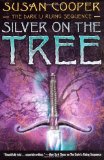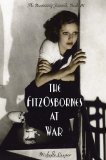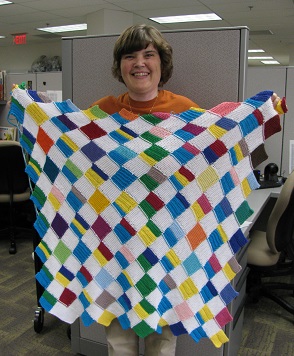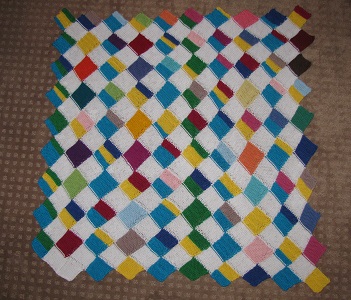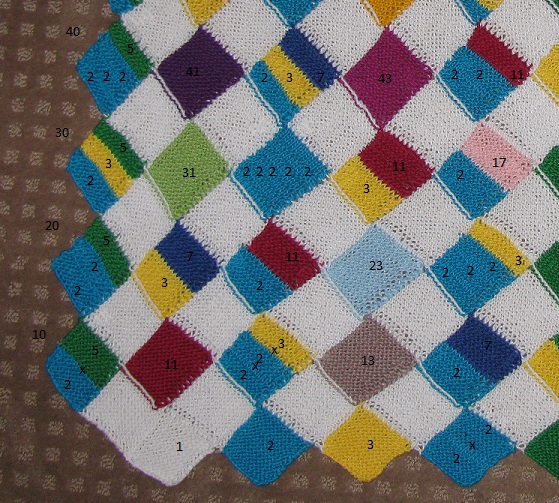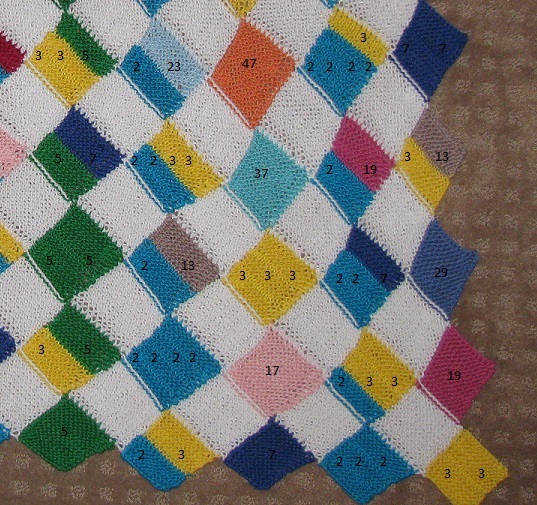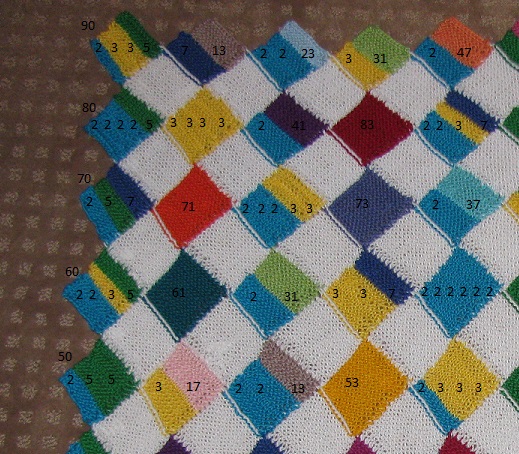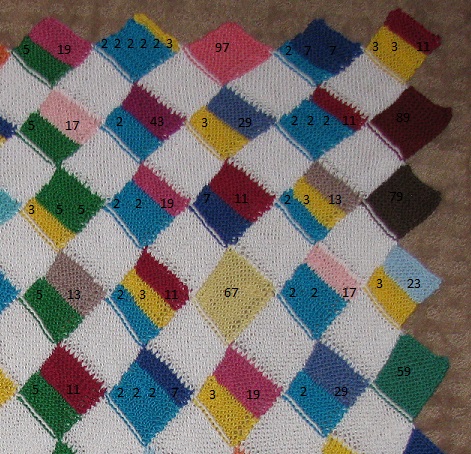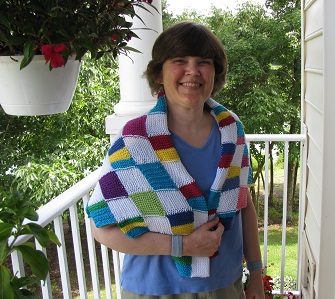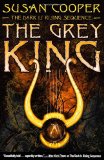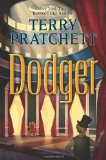On Wednesday, I finished knitting a Prime Factorization Blanket for my new little niece.
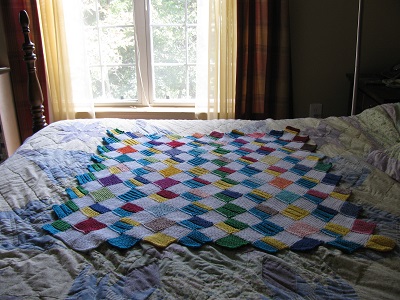
In my post about the blanket, I explained how the colors show the prime factorization of each number from 2 to 99. But I didn’t talk about the patterns, and I want to say a little bit about that here.
In fact, the only reason the Prime Factorization Blanket isn’t quite as good as the Prime Factorization Sweater is that I can’t have rows of 8 on the back and rows of 2 and 3 on the sleeves.
And the Prime Factorization Scarf is good for getting the flow of the numbers.
However, I do think the patterns in the 10 by 10 grid are a little easier to see with the larger diamonds on the blanket. Here’s the complete blanket laid out:
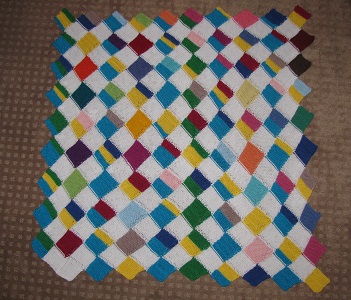
Let’s start by looking at the diagonals. 11 is 1 bigger than the base of 10. So the color for 11, red, goes in a diagonal across the blanket from the bottom left to the top right.
9 is 1 less than the base of 10. 9 = 3 x 3, so every number with a factor of 9 has two sections of yellow, the color for 3. You can see the yellows going diagonally up the blanket from the bottom right to the top left.
Oh, and I nearly forgot the more obvious ones. Since 2 and 5 are multiples of 10, they line up in columns. Every second column has turquoise for 2, and every fifth has green for 5.
Once you’re used to focusing on one color, you can pick any color and watch how it distributes evenly around the blanket. Take 19 for example, dark pink. You can see it climb up the blanket from the bottom right to the top left on a steeper diagonal than the one for 9.
And if you look at the colors it’s paired with, first it matches with 2, then with 3, then with two sets of 2, then with 5.
Another fun pattern is that the columns are sets of numbers that are congruent mod 10. So if you add, subtract, multiply or divide any two numbers in the same columns, your result will be in the same column.
For example, 2 + 17 = 19. Well, 62 + 27 = 99. The numbers in the second equation are from the same columns as the numbers in the first equation.
And that’s only the beginning of the patterns you can find.
Now that I’ve mailed off the blanket, I’m consoling myself by getting excited about the Pascal’s Triangle Shawl I’m going to make.
Pascal’s Triangle is formed by starting with 1, then adding a row of numbers where each number below is the sum of the two numbers above it.
Here’s how it works:
1
1 1
1 2 1
1 3 3 1
1 4 6 4 1
1 5 10 10 5 1
1 6 15 20 15 6 1
1 7 21 35 35 21 7 1
1 8 28 56 70 56 28 8 1
1 9 36 84 126 126 84 36 9 1
1 10 45 120 210 252 210 120 45 10 1
1 11 55 165 330 462 462 330 165 55 11 1
1 12 66 220 495 792 924 792 495 220 66 12 1
1 13 78 286 715 1287 1716 1716 1287 715 286 78 13 1
1 14 91 364 1001 2002 3003 3432 3003 2002 1001 364 91 14 1
1 15 105 455 1365 3003 5005 6435 6435 5005 3003 1365 455 105 15 1
The cool thing? Even though you’ve got really big numbers, when you factor them, the only prime factors are ones that have already appeared in the triangle. So I only need colors for the prime factors 2, 3, 5, 7, 11, and 13.
I’m stopping at row 15, because on row 16, we’ve got numbers with more than 6 prime factors, and that’s the most I’m prepared to accommodate unless I make my diamonds bigger. But up to 15 is going to be lovely.
I chose colors yesterday and tried to order the same colors. I’m not sure the ones I have aren’t discontinued colors by now, but when my order arrives, I can get going. (In fact, I’ve already started with the colors I have, hoping I won’t have to take out too much.) Here’s the color scheme I chose, using Cotton Classic yarn by Tahki.
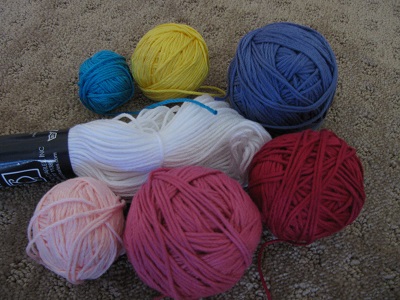
2 is on the bottom left, and then it goes around counterclockwise. So 2 will be pale pink, 3 will be rose, 5 will be red, 7 will be purple, 11 will be yellow, and 13 will be turquoise. And they are going to repeat in beautiful ways, just you wait!
I’ve already begun, though if it turns out that the pink I’ve ordered is a different shade from what I have, I’ll have to take out the square for 2 that I’ve begun. But I can’t stand waiting for the order!

You can see there the initial diamond for the first row: 1.
Second row has two diamonds for the second row: 1 1
Third row, I’ve knitted the first diamond for 1, and I’ve begun the next diamond, for 2.
When I get to the row with 4, I will start showing the prime factorization, so 4 will be listed as 2 x 2, with two sections of pink.
The way I’ll show the prime factorization will be exactly like the blanket, but the patterns will be very different, always with the diamond representing the sum of the two numbers on its lower edges.
And it will get cool on the top edge with numbers like 6435 = 3 x 3 x 5 x 11 x 13
I can’t wait to show pictures of the final result. I think it will be beautiful!
My posts on Mathematical Knitting and related topics are now gathered at Sonderknitting.
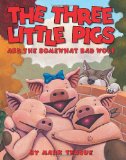 The Three Little Pigs and the Somewhat Bad Wolf
The Three Little Pigs and the Somewhat Bad Wolf